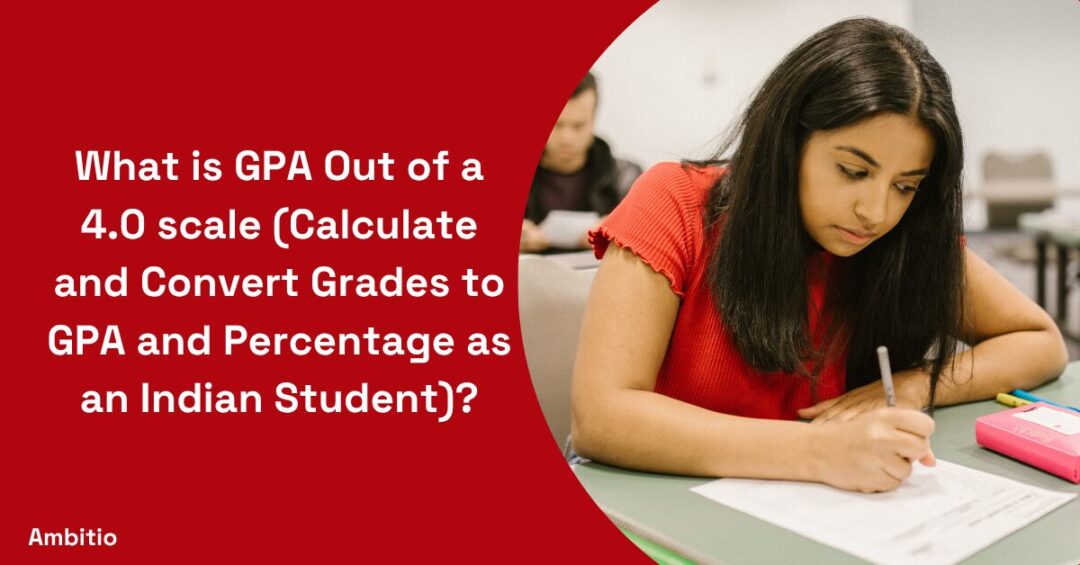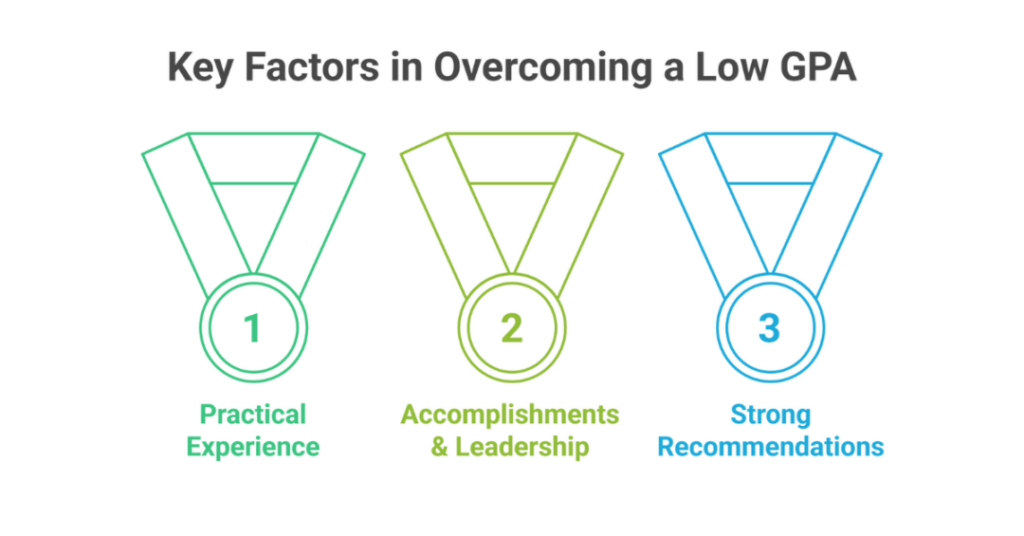9 July 2025
9 minutes read
What is GPA Out of a 4.0 scale (Best Ways to Calculate and Convert Grades to GPA and Percentage as an Indian Student)?

Key Takeaways
- What is GPA out of depends on the country—commonly it’s calculated on a 4.0 scale in the USA and a 10.0 scale in India.
- What is GPA out of is essential to understand before applying abroad, as universities convert grades to their own standard GPA scale.
- What is GPA out of helps students gauge eligibility—always check if your marks align with the 4.0 GPA requirement of most global universities.
“Why is GPA so significant?” Understanding why GPA, or Grade Point Average, matters so much is crucial to students on their way to a degree. A good GPA affects college admissions, scholarships, and future career prospects, making it an important consideration in a student’s life.
This blog explores the different types of GPAs, how they’re estimated, global discrepancies, and how they affect academic and professional success.
What is GPA (Grade Point Average)?
GPA Grading System or Grade-Point Average, is a numerical average of a student’s performance. It is determined by equating letter grades to a standard numerical point scale, usually between 0 and 4.0-GPA. A grade of A equals a 4.0-GPA, B equals 3.0, C equals 2.0, D equals 1.0, and F equals 0.0.

Weighted GPAs are utilized by some schools, taking the level of difficulty of courses such as honours and AP classes into consideration, usually on a 5.0 scale. GPA plays a significant role in college admissions, scholarships, and measuring overall academic performance.
Is Average GPA and Overall GPA So Important?
Here’s why GPA really matters in various aspects of a student’s academic and professional life:
- College Admissions: Universities use GPA other than test scores like IELTS, TOEFL, GRE and SAT to evaluate academic performance and accept students.
- Scholarships: A high GPA is often required for scholarship eligibility.
- Job Market: Employers may consider GPA when assessing a candidate’s capabilities.
- Academic Progress: GPA reflects a student’s overall academic achievement.
- High School Ranking: Many high schools use GPA to rank students and determine honours.
- Course Rigor: Weighted GPA accounts for the difficulty of courses like honours and AP classes.
- Financial Aid: Some financial aid options require a minimum GPA.
- Self-Assessment: GPA helps students track their academic progress and identify areas for improvement.
What are the Different Types of GPAs on the Grade Scale?
It is crucial for students who wish to excel academically and qualify for college admissions, scholarships, and financial aid to understand the various forms of GPAs and their application worldwide.
Unweighted GPA
The unweighted GPA is calculated on a 4.0 GPA scale, without considering course difficulty. It’s commonly used in the United States and Canada. In this GPA scale, letter grades directly correspond to GPA points: A = 4.0, B = 3.0, C = 2.0, D = 1.0, and F = 0.0. Many high-schools use this method to provide a straightforward measure of academic achievement.
Weighted GPA
A weighted GPA takes course difficulty, such as honours and AP classes, into account utilizing a weighted GPA scale. The scale may range up to 5.0 and even higher. An A in an AP course could be a 5.0, for instance, whereas an A in an ordinary course is a 4.0-GPA. This technique is common in U.S. high-schools in order to translate the difficulty of a student’s coursework.

Cumulative GPA
Cumulative GPA is the overall GPA of all the semesters. It is determined by taking the average of the GPAs for each term, divided by the total number of credit hours. It is employed by most universities worldwide in the context of college admissions, scholarships, and financial aid decisions.
Percentage-Based GPA
In India and some European countries, GPA is usually given in percentage. This type of system estimates letter grades to percentage and that percentage is represented by a grade point average. For example, 85% might be equal to a GPA of 3.5 on the 4.0-scale.
What is a GPA Scale?
A GPA scale is an organized system of measuring academic work through the translation of letter grades into numbers, usually between 0 and 4.0-GPA. The scale may differ, with weighted scales taking course difficulty into consideration, e.g., honours or AP courses, which tend to go up to 5.0.
Types of GPA Scales
Knowing various scales of GPA employed internationally is critical for students who want to measure their performance levels correctly and achieve global academic levels.
| Name of the Scale | Countries that Use the Scale | Description |
|---|---|---|
| 4.0 Scale | United States, Canada | Standard unweighted GPA scale; A = 4.0-GPA, B = 3.0, C = 2.0, D = 1.0, F = 0.0. |
| Weighted 5.0 Scale | United States | Accounts for course difficulty; A in AP/Honours = 5.0, B = 4.0-GPA, C = 3.0, etc. |
| Percentage Scale | India, European Countries | Grades estimated to percentages; e.g., 85% = A, with corresponding GPA points. |
| 10.0 Scale | India | Common in Indian universities; A+ = 10.0, A = 9.0, B+ = 8.0, etc. |
| 7.0 Scale | Australia | HD (High Distinction) = 7.0, D = 6.0, C = 5.0, P = 4.0-GPA, N = 0.0. |
| 20.0 Scale | France, some European Countries | Often used in French education; 20 = highest grade, 10 = pass, grades below 10 = fail. |
| 100 Scale | Various Asian and European Countries | Direct percentage scale; 100 = highest grade, typically with a pass mark around 50 or 60. |
| ECTS Scale | European Union | European Credit Transfer and Accumulation System; A = 90-100%, B = 80-89%, C = 70-79%, etc. |
| 5.0 Scale | Germany | 1.0 = Very Good, 2.0 = Good, 3.0 = Satisfactory, 4.0-GPA = Sufficient, 5.0 = Fail. |
GPA out of 4.0 Scale (4.0 GPA Scale)
Here is the easy-to-understand 4.0-GPA scale, indicating how numerical grades and GPA points correlate with letter grades:
| Letter Grade | Numerical Grade | GPA |
|---|---|---|
| A | 90-100% | 4.0 |
| B | 80-89% | 3.0 |
| C | 70-79% | 2.0 |
| D | 60-69% | 1.0 |
| F | Below 60% | 0.0 |
Different Grading System Across Countries
Following is a comparison of Indian percentage grades to GPA scales employed in the USA, UK, Australia, Canada, and Germany:
| Indian Percentage | USA (4.0-Scale) | UK (Class System) | Australia (7.0 Scale) | Canada (4.0- Scale) | Germany (5.0 Scale) |
|---|---|---|---|---|---|
| 90-100% | 4.0 | First Class (1) | 7.0 (HD) | 4.0 | 1.0 |
| 80-89% | 3.7 | Upper Second (2:1) | 6.0 (D) | 3.7 | 1.3-1.7 |
| 70-79% | 3.0 | Lower Second (2:2) | 5.0 (C) | 3.0 | 2.0-2.7 |
| 60-69% | 2.3 | Third Class (3) | 4.0 (P) | 2.3 | 3.0-3.7 |
| 50-59% | 2.0 | Pass | 3.0 (P) | 2.0 | 4.0 |
| Below 50% | 0.0-1.0 | Fail | 0.0-2.0 (N) | 0.0-1.0 | 5.0 |
How to Calculate GPA or Cumulative GPA With a GPA Calculator?
Calculating your cumulative GPA accurately is essential for understanding your academic performance and meeting educational goals. Calculators are useful tools for students to easily and accurately determine their grade point average.
They help in tracking academic progress, planning for future coursework, and meeting eligibility requirements for college admissions, scholarships, and financial aid. Additionally, GPA calculators can assist students in setting realistic academic goals and identifying areas that need improvement.
Here’s a step-by-step guide on how to calculate both unweighted and weighted GPAs.
Unweighted GPA Calculation
To calculate your GPA on an unweighted scale:
- Convert each of your letter grades to the corresponding number of grade points using the 4.0-scale.
- Add up all the grade points.
- Divide by the total number of classes.
For example, if you have three A’s (4.0 each), two B’s (3.0 each), and one C (2.0), the calculation would be:
(4.0+4.0+4.0+3.0+3.0+2.0) / 6 = 3.33

Weighted GPA Calculation
Weighted GPAs take the difficulty of the coursework into account:
- Convert your letter grades to grade points, but use a weighted scale for honours/AP courses.
- Add up all the grade points.
- Divide by the total number of credits.
If you have grades from two AP classes and three regular classes, your weighted GPA score calculation might look like this:
(5.0+5.0+4.0+3.0+3.0) / 5 = 4.0
How to Convert and Calculate Your GPA and Percentage?
A GPA converter is a tool used to translate GPA scores from one grading system to another. It helps students convert their GPA from one country’s scale to another’s, such as from a percentage to a 4.0 scale, facilitating international education applications and comparisons of academic performance.
Types of GPA Conversions
Understanding the different types of GPA conversions is essential for accurately comparing academic performance across various educational systems worldwide.
Percentage to GPA Conversion
Converting percentage grades to GPA is common for international students. For instance, a 90-100% might correspond to a 4.0 on the GPA scale. This conversion helps students applying to U.S. universities understand their academic standing.
4.0-Scale to 5.0 Scale Conversion
Some high schools use a 5.0 scale for weighted GPAs. Converting a 4.0-scale GPA to a 5.0 scale involves adjusting for course difficulty, such as honours or AP classes, to reflect more rigorous coursework.
International GPA Conversion
Different countries use various GPA scales. For example, Germany’s Grade Calculator operates on a 5.0 scale where 1.0 is the highest grade. Converting this to the U.S. 4.0-scale helps in applying to universities abroad and understanding academic equivalence.
Class System to GPA Conversion
In the UK, the class system (First Class, Upper Second) is used. Converting these classifications to a GPA scale can help UK students applying to universities in the U.S. and other countries that use a GPA system.
Letter Grades to GPA Conversion
Converting letter grades (A, B, C) to GPA involves assigning numerical values to each grade. For example, an A translates to 4.0, B to 3.0, etc. This standardization helps in consistent academic performance evaluation.
Importance of a Good GPA?
A good GPA is crucial for several reasons. It plays a significant role in college admissions, as many universities have minimum GPA requirements and consider it a key indicator of a student’s academic ability.
A high GPA can also qualify students for scholarships and financial aid, reducing the cost of education. Additionally, employers often look at GPA as a measure of a candidate’s dedication and competence.
A strong GPA reflects consistent academic performance and can open doors to advanced study opportunities, internships, and job offers, making it an essential factor in a student’s academic and professional success.
Good GPA in High school
A good GPA in high school typically ranges from 3.5 to 4.0 on a 4.0 scale. This range signifies strong academic performance and can significantly enhance college applications, as many universities prefer students with high GPAs. A strong GPA can also open opportunities for scholarships and honours programs, reducing educational costs and providing additional academic benefits.
Maintaining a good GPA throughout high school demonstrates dedication, consistency, and readiness for college-level coursework, making students more competitive in college admissions and future job markets. This solid academic foundation can pave the way for advanced study opportunities and successful careers.

Good GPA for College/ University
A good GPA is important for college or university admissions and it typically ranges from 3.0 to 4.0 on a 4.0-scale. A GPA of 3.0 or higher is often required for graduate school applications, scholarships, and honours programs. It indicates strong academic performance and can enhance job prospects, as many employers consider GPA when evaluating candidates.
A high GPA demonstrates a student’s ability to manage coursework effectively and excel in their field of study, making them competitive for advanced study opportunities, internships, and professional roles. Maintaining a good GPA throughout college also reflects dedication, consistency, and readiness for future academic and career challenges.
How is a Higher GPA Related to Scholarships & Financial Aid?
A higher GPA is closely related to scholarships because many scholarship programs have minimum GPA requirements. Typically, scholarships are awarded based on academic merit, and a high GPA demonstrates a student’s dedication and academic excellence.
Scholarship committees use GPA as a key criterion to identify deserving candidates who have shown consistent performance and potential for future success. Additionally, maintaining a higher GPA can make students eligible for more prestigious and substantial scholarships, reducing the financial burden of education and providing access to enhanced academic opportunities and resources.
Can Work Experience Make Up For a Low GPA or High GPA?
Yes, work experience can help compensate for an average GPA. Employers and graduate programs often value practical experience, skills, and achievements that demonstrate your capabilities beyond academic performance. Relevant work experience can showcase your dedication, hands-on expertise, and ability to apply knowledge in real-world situations.
Highlighting accomplishments, leadership roles, and specific projects in your resume and during interviews can effectively offset a lower GPA.
Additionally, strong letter of recommendation, statement of purpose and resume from supervisors and a compelling personal statement can further strengthen your application, proving that you possess the qualities and experience necessary for success.
How to Improve Your Low GPA?
Improving a low GPA requires strategic planning and effort.
Here are practical steps to help you boost your academic performance and achieve a higher GPA.
- Focus on Weak Areas: Identify subjects where your grades are lower than your average GPA and allocate more study time to these areas.
- Seek Help: Utilize tutoring services, study groups, and office hours to get assistance and improve understanding.
- Improve Study Habits: Develop effective study routines and avoid procrastination to maximize your time at university.
- Take Advantage of Extra Credit: Participate in extra credit assignments to boost your grades.
- Retake Courses: If possible, retake classes in which you scored poorly to replace low grades with higher ones.
- Stay Organized: Keep track of all assignments and exams to ensure nothing is missed.
- Use a GPA Calculator: Regularly calculate your average GPA to monitor progress and set realistic goals towards achieving the highest GPA possible.
Conclusion
Maintaining a good GPA is vital for academic and professional success, influencing college admissions, scholarships, and job prospects. By understanding GPA scales, improving study habits, and leveraging work experience, students can enhance their academic performance and open doors to numerous opportunities and resources.
Expert Advice, Tailored for You:Every student’s journey is unique. Book a tailored advice session with our mentor to navigate the college application process your way.
FAQs
What is GPA out of in the United States?
What is GPA out of in the U.S.? It’s typically on a 4.0 scale. If you’re wondering what is GPA out of for American universities, it’s almost always 4.0. So next time someone asks what is GPA out of, remember: 4.0 is the standard.
What is GPA out of in the Indian education system?
What is GPA out of in India? Indian universities often use a 10-point scale. If you’re converting grades, knowing what is GPA out of helps compare systems. So, what is GPA out of in India? Usually, it’s 10.
What is GPA out of when converting percentages to GPA?
What is GPA out of when you’re using percentage marks? Typically, it’s out of 4.0 for U.S. systems. Understanding what is GPA out of is crucial to estimate eligibility. For most conversions, what is GPA out of is 4.
What is GPA out of for Canadian universities?
What is GPA out of in Canada? Many Canadian institutions use a 4.0 or 4.33 scale. Knowing what is GPA out of is important before applying. So, what is GPA out of in Canada? Often, it’s between 4.0 and 4.33.
What is GPA out of for UK admissions?
What is GPA out of for UK institutions? The UK usually uses class-based grading, not GPA, but conversions use a 4.0 scale. When checking what is GPA out of, remember GPA equivalents matter. That’s what is GPA out of in context.
What is GPA out of on international transcripts?
What is GPA out of internationally? It varies by country: 4.0, 5.0, or 10.0 scales are common. Before applying, check what is GPA out of in that region. Always verify what is GPA out of on your transcript for accuracy.
What is GPA out of for graduate school applications?
What is GPA out of when applying for a master’s or PhD? It’s most often 4.0 in U.S. and Canadian schools. Knowing what is GPA out of helps set goals. So, always clarify what is GPA out of on the application portal.

You can study at top universities worldwide!
Get expert tips and tricks to get into top universities with a free expert session.
Book Your Free 30-Minute Session Now! Book a call now




























